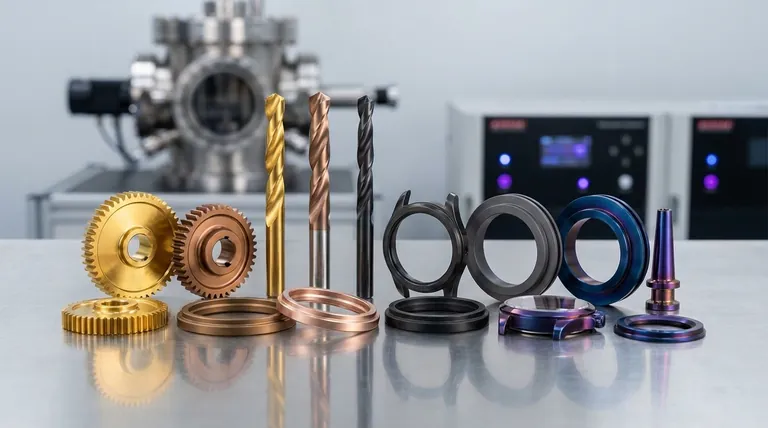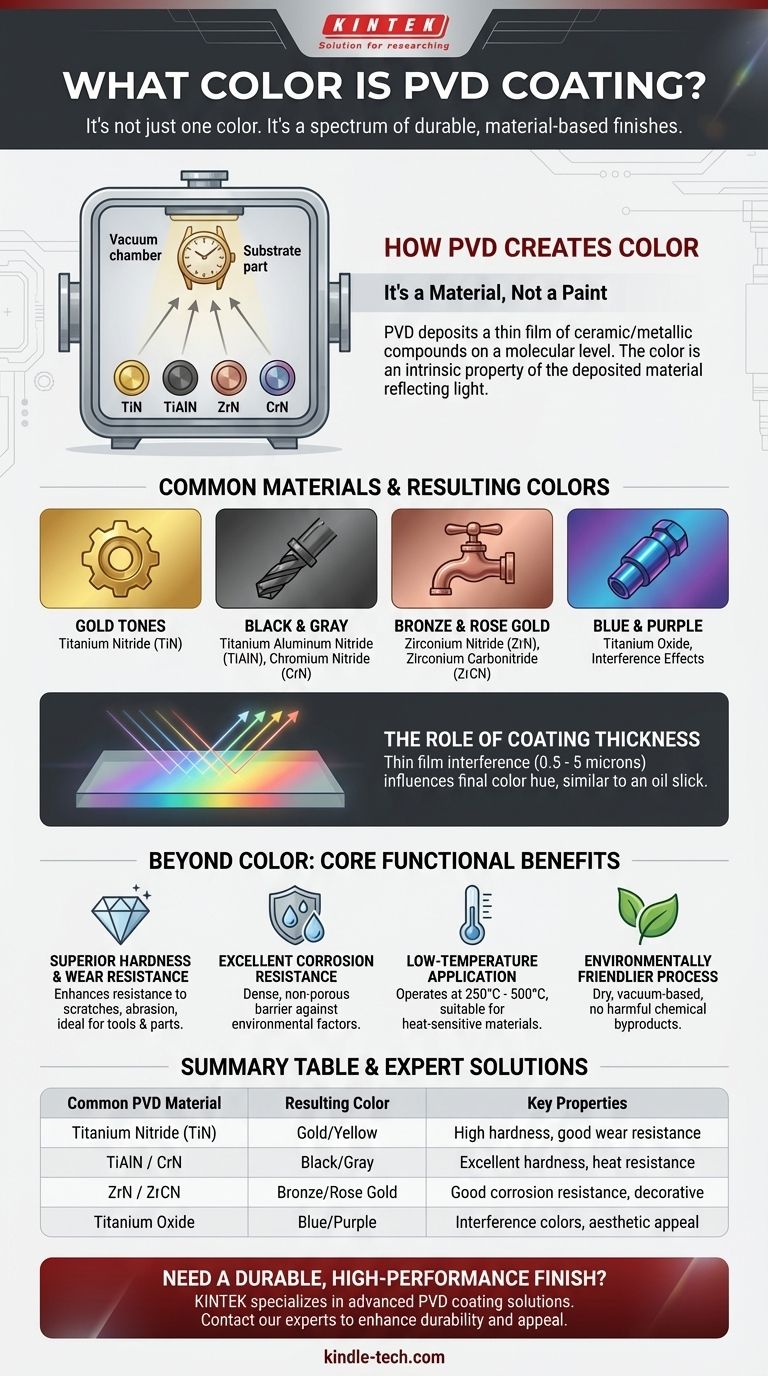To be precise, PVD coating does not have one single color. Instead, Physical Vapor Deposition (PVD) is a process that can produce a wide spectrum of durable, metallic colors by depositing a very thin film of specific ceramic or metallic compounds onto a substrate. The final color is an intrinsic property of the material being deposited, not a pigment or dye.
The color of a PVD coating is determined by the material being applied on a molecular level. It is not a paint or plating, but a thin, durable ceramic film whose composition dictates its final appearance, from gold and black to bronze and even blue.

How PVD Creates Color
The color in a PVD finish is a direct result of the specific material being deposited in a vacuum chamber. This process changes the properties of the metal surface itself, creating a finish that is integrated with the substrate.
It's a Material, Not a Paint
Unlike painting or powder coating, PVD does not add a separate layer of colored pigment. The process physically bonds a thin film of a ceramic compound to the substrate, one molecule at a time. The perceived color is how that specific compound reflects light.
For example, Titanium Nitride (TiN) inherently appears as a gold color, while Titanium Carbonitride (TiCN) appears as a shade of gray or rose.
Common Materials and Resulting Colors
By selecting different source materials and introducing reactive gases like nitrogen or methane into the vacuum chamber, a range of stable, reproducible colors can be achieved.
- Gold Tones: Achieved with Titanium Nitride (TiN).
- Black and Gray: Commonly produced with Titanium Aluminum Nitride (TiAlN) or Chromium Nitride (CrN).
- Bronze and Rose Gold: Achieved with Zirconium Nitride (ZrN) or Zirconium Carbonitride (ZrCN).
- Blue and Purple: Can be created with Titanium Oxide or by carefully controlling coating thickness to create an interference effect.
The Role of Coating Thickness
The thickness of the PVD coating, typically between 0.5 and 5 microns, can also influence the final perceived color. This phenomenon, known as thin-film interference, is similar to how a rainbow effect appears on an oil slick. Light waves reflecting off the top and bottom surfaces of the thin film interfere with each other, canceling out certain colors and reinforcing others.
Beyond Color: The Core Functional Benefits
While PVD provides a variety of decorative finishes, its primary purpose in industrial applications is to dramatically improve the functional properties of the underlying material.
Superior Hardness and Wear Resistance
PVD coatings form a ceramic layer with exceptionally high hardness. This significantly enhances a product's resistance to scratches, abrasion, and general wear, making it ideal for tools, watches, and architectural hardware.
Excellent Corrosion Resistance
The deposited film is dense and non-porous, creating a robust barrier against environmental factors. This makes the surface highly resistant to corrosion, oxidation, and tarnishing from things like salt spray or chemicals.
Low-Temperature Application
The PVD process operates at relatively low temperatures, typically between 250°C and 500°C. This makes it suitable for coating heat-sensitive materials that would be damaged or distorted by higher-temperature processes like Chemical Vapor Deposition (CVD).
An Environmentally Friendlier Process
PVD is a dry, vacuum-based process that does not produce the harmful chemical byproducts associated with traditional electroplating. This makes it a more environmentally responsible finishing technology.
Understanding the Trade-offs
No process is without its limitations. Objectivity requires understanding where PVD might not be the ideal choice.
Line-of-Sight Deposition
The PVD process generally works on a "line-of-sight" basis. This means it is very effective at coating external surfaces but can struggle to evenly coat complex internal geometries or deep, narrow holes where the vapor cannot travel.
Substrate Preparation is Critical
The high adhesion and durability of a PVD coating are entirely dependent on the quality of the substrate surface. The part must be impeccably clean and free of any oils, oxides, or imperfections, as the coating will replicate the underlying surface texture.
Color Consistency Can Be a Challenge
Achieving perfect color consistency from batch to batch requires extremely tight control over the process parameters. Minor variations in vacuum pressure, gas mixture, or temperature can lead to subtle shifts in hue, which can be a concern for high-volume consumer products.
Making the Right Choice for Your Finish
Selecting the right finish depends on balancing your aesthetic goals with your performance requirements.
- If your primary focus is a specific decorative color: PVD offers a durable, high-end metallic finish in a variety of colors that far surpasses the longevity of simple plating.
- If your primary focus is extreme hardness and tool life: PVD is a leading choice for extending the life of cutting tools and industrial components due to its hardness and low-friction properties.
- If your primary focus is a balance of aesthetics and performance: PVD is an excellent choice for consumer goods like jewelry, watches, and fixtures, providing a premium look with exceptional resistance to wear and corrosion.
Ultimately, choosing PVD is about selecting a surface engineering process that delivers both the look you want and the physical performance you need.
Summary Table:
| Common PVD Material | Resulting Color | Key Properties |
|---|---|---|
| Titanium Nitride (TiN) | Gold/Yellow | High hardness, good wear resistance |
| Titanium Aluminum Nitride (TiAlN) | Black/Gray | Excellent hardness, heat resistance |
| Zirconium Nitride (ZrN) | Bronze/Rose Gold | Good corrosion resistance, decorative |
| Titanium Oxide | Blue/Purple | Interference colors, aesthetic appeal |
Need a durable, high-performance finish for your components? KINTEK specializes in advanced PVD coating solutions for laboratory equipment, tools, and precision parts. Our coatings provide superior hardness, corrosion resistance, and a wide range of metallic colors that are integrated into your substrate for long-lasting performance. Contact our experts today to discuss how our PVD technology can enhance your product's durability and aesthetic appeal.
Visual Guide

Related Products
- Custom CVD Diamond Coating for Lab Applications
- RF PECVD System Radio Frequency Plasma-Enhanced Chemical Vapor Deposition RF PECVD
- Vacuum Hot Press Furnace Machine for Lamination and Heating
- Customer Made Versatile CVD Tube Furnace Chemical Vapor Deposition Chamber System Equipment
- Split Chamber CVD Tube Furnace with Vacuum Station Chemical Vapor Deposition System Equipment Machine
People Also Ask
- What is diamond coating film? A Thin Layer of Diamond for Extreme Performance
- What is the process of CVD diamond coating? Grow a Superior, Chemically-Bonded Diamond Layer
- What is CVD diamond coating? Grow a Super-Hard, High-Performance Diamond Layer
- How long does diamond coating last? Maximize Lifespan with the Right Coating for Your Application
- Is diamond coating worth it? Maximize Component Life and Performance



















